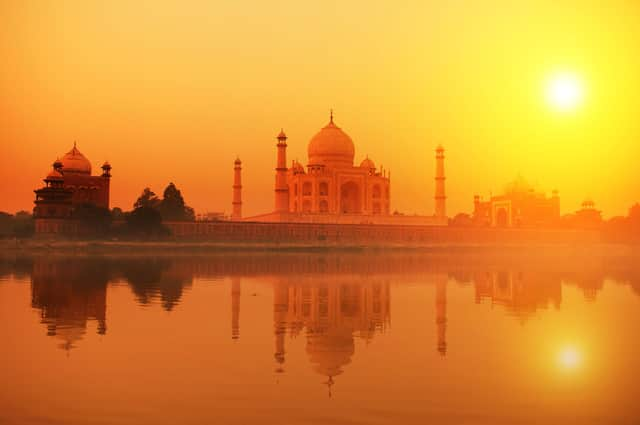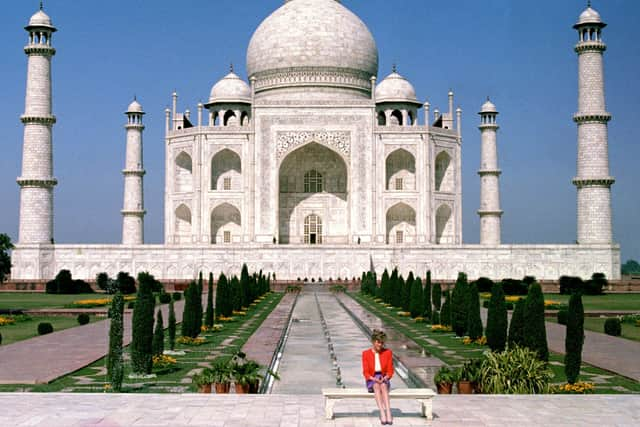Why I shed a tear for my father when I visited the Taj Mahal - Christa Ackroyd


The Taj Mahal is so much more than a white mausoleum built in the 17th century by a Mughal emperor mourning his favourite wife. It has become a universal symbol of love. It topped the list of the modern wonders of the world. And, of course, it was the setting for one of the most iconic photographs of the 20th century when Princess Diana sat alone in front of the mammoth marble masterpiece without her husband. Then it symbolised the end of her marriage.
The marble was transported by 1,000 elephants from Rajasthan and it took more than 20 years to build. Twenty-two thousand labourers, painters and stone cutters were employed. Twenty-eight different semi-precious stones were inlaid with jasper from the Punjab, jade from China and sapphires from Sri Lanka. It cost the equivalent of more than half a billion pounds and to appreciate its beauty you have to see it at sunrise or sunset when the marble takes on an almost mythical quality.
Advertisement
Hide AdAdvertisement
Hide AdThree weeks ago, that is how I saw it emerging from the darkness, shimmering in the morning sun. And it lit up my heart.


You see 40 years earlier, my father and I made plans to visit the Taj Mahal and travel India together. He had been in India after being awarded a Commonwealth Bursary for his work as a race relations officer for West Yorkshire Police and had come home with stories from a country he fell in love with, and one which welcomed him with open arms.
People who had made their home in Bradford insisted he stayed with their families during his visit. And he was beguiled by the natural charm, beauty and hospitality that is India then and now. Among the gifts he brought home was a Kashmir shawl for mum (now a cherished family heirloom), which was worn to many a police dinner, and a little marble copy of the Taj Mahal. We planned to see the real thing together one day.
But you know what they say “Man makes plans and God laughs”. We never made that trip. Ill-health forced early retirement and he died relatively young. But I promised him I would go with my husband one day. And we did. And a photo of my dad came with us. My husband said the sight of the Taj Mahal made him shudder. My friend was unusually quiet.
Advertisement
Hide AdAdvertisement
Hide AdAnd I shed a tear, a happy tear, for a good man who planned to show it to me in person.
I am lucky enough to have been to India three times now. The first occasion I visited was in the Eighties with the leaders of Leeds City Council who planned to twin the city with a town in the Punjab. That visit saw violence erupt on the day we were taken to the Golden Temple at Amritsar, the holiest shrine of the Sikh religion. We heard the gunshots as we were hurried away.
The Indian army stormed the temple seeking out militants who were fighting for a separate state. Hundreds died and Indian Prime Minister Indira Gandhi was assassinated by her bodyguards in retaliation. The twinning plans were shelved and the siege of the temple lasted another four years. It was, as India so often is, heartbreaking.
The second time I visited I was in Mumbai seeking out the story of India’s Bollywood, the largest film industry in the world which churns out 1,000 films a year. The Bollywood Oscars were coming to Sheffield and we were there to film the filming.
Advertisement
Hide AdAdvertisement
Hide AdIndia is nothing if not a slave to red tape, as our guide this year cynically pointed out, “that is the legacy you British left us”, and that trip certainly had its moments.
Though for me the saddest memory was when we were asked not to film the poverty, because it was bad for tourism. We did, of course. Not to would have been to ignore India’s greatest problem, the divide between the haves and the have-nots, that see children raised in tent villages and people sleeping on the pavements.
This year India seemed more positive. The streets were cleaner and not just for President Trump’s visit. They were cleaner in other cities, too. Young people spoke of hope for the future and of a government’s plan to tackle the plight of the poor, not least by building 45 million toilets in homes largely in rural areas to improve sanitation.
Huge tents had been erected offering shelter for the 150,000 homeless who live on the streets. And there was much talk of plans for free health care for half a billion people.
Advertisement
Hide AdAdvertisement
Hide AdIn Delhi, we saw hundreds of women and children protesting peacefully over a controversial new plan which fast tracks only non-Muslims applying to live in India seemingly on the basis that Muslims can find a home elsewhere, including in neighbouring Pakistan.
Women’s voices were being heard at last, it seemed. And that is something new for a country described to my husband by one guide as a place where, fortunately, he said, the men are still in charge.
Only three days after we left, rioting broke out in Delhi over fears that a national census could lead to more discrimination against Muslims many of whom do not possess the necessary birth certificates. Forty are dead and the country is again in turmoil. Oh India, I love you, but I could weep for you.
I will visit India again. It seeps into your soul. But I will not visit the Taj Mahal, that legacy is complete 40 years after we planned it. I know you were with me, dad. You always are.
Comment Guidelines
National World encourages reader discussion on our stories. User feedback, insights and back-and-forth exchanges add a rich layer of context to reporting. Please review our Community Guidelines before commenting.